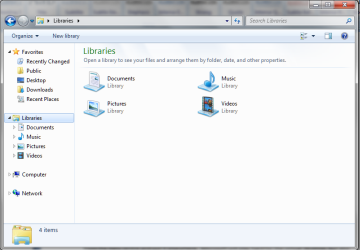Hands-on with Windows 7: How it worked for me

Quocirca's Straight Talking: The best of times, the worst of times
Clive Longbottom has got his hands on Windows 7. So what does he think: Microsoft saviour or Vista all over again? Read on…
I've spent the last couple of days with Windows 7. The experience brings to mind that famous phrase: "It was the best of times, it was the worst of times".
Windows 7 became available for IT professionals subscribing to Microsoft's TechNet on 6 August, and, for a change, Microsoft had sized its servers so that people could download the operating system without everything grinding to a halt.
I've been running various versions of Windows 7 on a couple of laptops for some time, and have been reasonably impressed with its overall look, feel and response, as well as the fact that it actually runs the majority of applications I threw at it.
In comparison to when Vista first came out, Windows 7 did not seem to need a massive amount of system resources; it didn't seem to suffer from a dearth of device drivers; and application compatibility - while not brilliant - was far in excess of Vista.
Indeed, after the original alphas and beta of Windows 7 were released, Microsoft agreed that including a virtual PC capability for running Windows XP was a good idea. This enables companies to carry on using applications that would not run natively under Windows 7.
But back to the experience of upgrading to Windows 7. The pre-retail versions of Windows 7 cannot be easily upgraded to the full version, so I decided to bite the bullet and upgrade my main desktop machine first. This is a 64-bit Mesh quad-core AMD-based system, which was currently running Vista Ultimate 64-bit.
The upgrade is almost completely hands-off: once the image is loaded up and you have said you want to carry out an upgrade rather than a new partition installation, you can go and make a cup of coffee, have a walk, read a book, or, it would seem, build a small extension.
In my case, the upgrade did not occur rapidly: it took over two-and-a-half hours. But I was relieved and pleasantly surprised when the machine finally rebooted, with everything working.

Windows 7 Libraries (Image credit: Clive Longbottom)
Now onto my laptop - a Lenovo X200 tablet set as a dual-partitioned device with Vista Ultimate 32-bit on one partition and Windows 7 Ultimate RC on the other. I decided to use the 'other' installation choice and pointed the Windows 7 installation at the Vista partition. The 'upgrade' (or overwrite) occurred rapidly, and again it looked like I had a clean machine on the final re-boot.
But then the problems began... Click here to read page two of this article
It soon became apparent I had no biometric fingerprint capability, no touchscreen and no wireless WAN. This was not a massive surprise to me - installing previous versions of Windows 7 on my two Lenovo machines left me with the firm impression that Lenovo has not had its finger on the pulse.
Whereas other analysts I have spoken to with HP or other tablet devices have found it easy to install Windows 7, my experience with Lenovo has been horrendous. Its main site has no Windows 7 drivers on it. If you manage to find the site where the Windows 7 drivers are being dribbled out, it offers no explanation of what's really needed and what's not.
On Lenovo's support forum, its engineers stated they did not see why Lenovo should be issuing drivers for an unreleased operating system, but that full support would be available when the final version of Windows 7 was released.
I've got news for you guys: Windows 7 is here for much of the world! Yet your website still only has Vista drivers and your Windows 7 beta drivers don't work in many cases.
Now, Microsoft cannot escape all the blame here. If it can provide out of the box support for the majority of other tablets, a bit of pressure on Lenovo would surely have been productive.
Despite the hiccups I now have a fully working Windows 7 desktop machine, and a laptop with no biometric security and no WWAN capability.
So what's my view of Windows 7?
It's fast. It's got the looks.
Windows 7 should be capable of running the vast majority of Windows-based applications that a business could want to run. It has a much better security model than Windows XP, which is the platform that most businesses are still dependent on. It isn't the resource hog that Vista was, and so can run on far more existing machines than Vista can.
However, there do seem to be a few problems. Explorer is somewhat fragile, and the dreaded 'Explorer has stopped responding' message appears on both machines with alarming frequency. Thankfully it does rescue itself successfully on the whole.
Windows 7 Media Centre (Image credit: Clive Longbottom)
IE8 renders pages differently to Firefox or Chrome, and the compatibility mode will not be intuitive to the average user. For those who have stumped up the dosh for Vista Ultimate, they'll find that DreamScene is no longer (although there are hacks on the internet to get it to work again).
Now onto the bigger question here: will Windows 7 be Microsoft's saviour?...
Click here to read page three of this article
Judging by Microsoft's most recent set of financial figures, it appears as if consumers and businesses alike have decided to wait for Windows 7.
With Microsoft having pushed out the betas and release candidates to many large organisations and IT professionals over a prolonged period, a large proportion of the real testing of Windows 7 has already occurred.
Uptake of Windows 7 is likely to be far more rapid than it has been for other Windows versions - meaning Microsoft could finally draw the veil over the incredibly poor Vista.
However, businesses are changing the ways they use technologies, and Microsoft will have to show that it can respond to this. Full-blown clients are being moved into the datacentre with virtual desktops and thin client computing. Software as a service and cloud computing will take a lot of functionality from the data centre and put it elsewhere.
Microsoft will play hard for the virtual desktop but also has to ensure that the client device itself will be Microsoft-based. If it can do this, it wins in multiple ways - it will have the virtual desktop environment, the servers these sit on and the client device from which users are accessing resources.
Windows 7 Time Zones (Image credit: Clive Longbottom)
Windows 7 looks like it will offer a scalable solution that can play in a range of access devices and in the virtual desktop arena too. The Linux camp and others such as Google with its recently announced Chrome OS will doubtlessly fight hard to stop this but at least Microsoft is now in a better position to respond.
Let battle commence!
A leading user-facing analyst house known for its focus on the big picture, Quocirca is made up of a team of experts in technology and its business implications. The team includes Clive Longbottom, Bob Tarzey, Rob Bamforth, Louella Fernandes, Fran Howarth and Simon Perry. Their series of columns for silicon.com seeks to demystify the latest jargon and business thinking. For a full summary of the consultancy's activities, see www.quocirca.com.